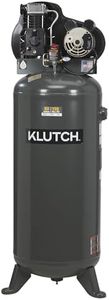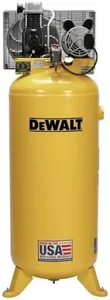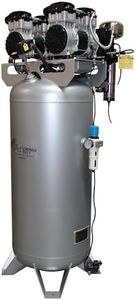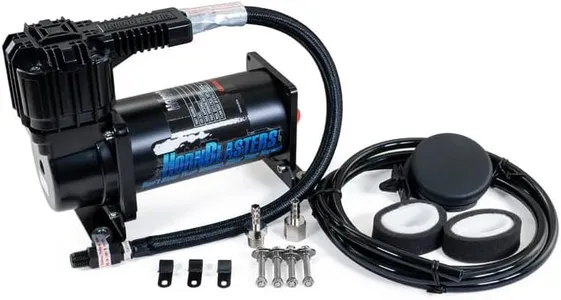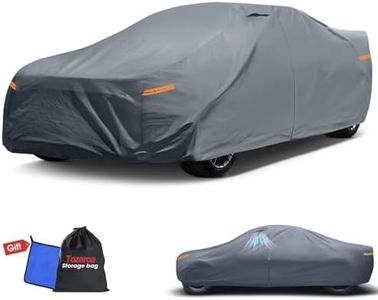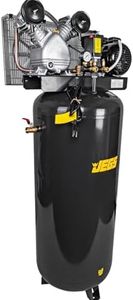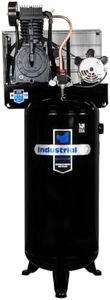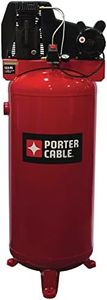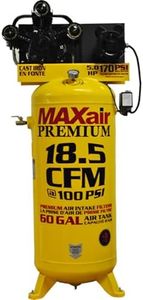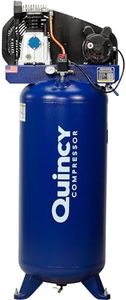10 Best 60 Gallon Air Compressors 2025 in the United States
Our technology thoroughly searches through the online shopping world, reviewing hundreds of sites. We then process and analyze this information, updating in real-time to bring you the latest top-rated products. This way, you always get the best and most current options available.

Our Top Picks
Winner
Klutch 60-Gallon Single-Stage Vertical Air Compressor, 3.7 HP, 230 Volts
Most important from
282 reviews
The Klutch 60-Gallon Single-Stage Vertical Air Compressor is a solid choice for those needing a mid-sized, powerful air compressor for home workshops or light commercial use. It features a strong 3.7 HP motor that delivers 9.3 CFM at 90 PSI, suitable for running a variety of pneumatic tools efficiently. The maximum pressure of 135 PSI offers enough power for most tasks in its class. The 60-gallon vertical tank allows for longer tool run times without frequent motor cycling, which is good for consistent work.
The oil-lubricated pump with cast iron construction and stainless steel valves adds durability and reliability, meaning the compressor can handle repeated use over time. The unit weighs 220 pounds and is not designed for portability, so it’s best suited to a fixed workspace rather than moving around frequently. The compressor runs on 230 volts, so it requires the appropriate power source, which might limit use in some home settings without electrical upgrades. This model has received favorable user ratings, indicating satisfaction with its performance and build quality.
This compressor is a dependable and powerful option if you need a steady air supply for medium-duty jobs and don’t require portability. Additionally, oil-lubricated compressors tend to be quieter than oil-free models, which is a plus for indoor use.
Most important from
282 reviews
California Air Tools CAT-60040CAD 4.0 HP Ultra Quiet and Oil-Free Air Compressor, 60 Gallon Steel Tank, 75 dBA Noise Level
Most important from
73 reviews
The California Air Tools CAT-60040CAD is a 60-gallon air compressor designed for those needing a quiet yet powerful option for various tasks like tire inflation and air brushing. One of its standout features is its ultra-quiet operation at just 75 dBA, making it a great fit for noise-sensitive environments, such as residential areas or workshops. The dual motor design not only produces a respectable airflow of 10.6 CFM at 90 PSI, but it also operates at lower RPMs, which helps reduce wear and tear, extending the lifespan of the machine.
The oil-free dual piston pump is another significant advantage, providing a maintenance-friendly experience and cleaner air, which is essential for fine applications like air brushing. Its large 60-gallon steel tank ensures ample air storage, catering to larger jobs without frequent refills.
Weighing in at 213 pounds, portability might be a challenge for some users, especially those looking for an easy-to-move unit. The 220-volt requirement also means you need to ensure compatibility with your electrical setup, as standard outlets may not suffice. While the warranty is a positive aspect, some may find it limited given the investment in such a machine. This air compressor is well-suited for users who prioritize noise reduction and efficiency, making it ideal for both professional and home use. Just remember to consider the weight and power requirements when making your choice.
Most important from
73 reviews
EMAX Silent Air Industrial Air Compressor - 5HP 60 Gal 19CFM Single Stage Vertical Compressor with Splash Lubricated Pump, Isolator Pads & Oil for First Change - Made in the USA - ESS05V060V1
The EMAX Silent Air Industrial Air Compressor is a solid choice if you need a powerful, quiet, and reliable 60-gallon air compressor for industrial tasks. It delivers 19 cubic feet per minute (CFM) at 90 PSI, which is strong enough for various uses like drilling, sanding, or tire inflation. With a 5-horsepower motor and a maximum pressure of 150 PSI, it provides plenty of power for demanding jobs.
The vertical 60-gallon tank is made of durable alloy steel and cast iron components, ensuring long-lasting performance. One standout feature is its patented Silent Air Technology, which cuts noise down to about 35 decibels—much quieter than many compressors—making it better suited for indoor or noise-sensitive environments. The compressor also comes with isolator pads to reduce vibration and includes oil for the first maintenance, helping with smooth operation from the start.
This model is stationary and corded, which means it isn’t portable or battery-powered, so it’s best for a fixed workshop or industrial setting rather than on-the-go use. If your work requires a powerful, quiet compressor that can run reliably for extended periods, this EMAX model fits those needs well but is designed for more permanent setups rather than portable jobs.
Buying Guide for the Best 60 Gallon Air Compressors
Choosing the right 60-gallon air compressor can significantly impact the efficiency and effectiveness of your work, whether you're using it for professional tasks or DIY projects. The key is to understand the various specifications and how they align with your specific needs. By focusing on the right specs, you can ensure that you get a compressor that meets your requirements without overpaying for features you don't need.FAQ
Most Popular Categories Right Now
